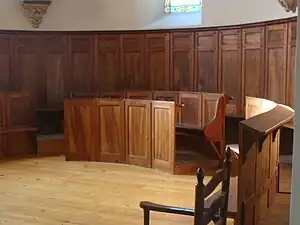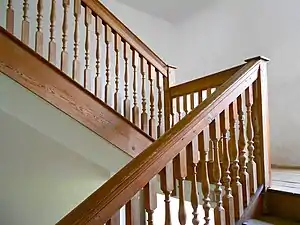_(14774970544).jpg.webp)
Millwork is historically any wood mill produced decorative materials used in building construction. Stock profiled and patterned millwork building components fabricated by milling at a planing mill can usually be installed with minimal alteration. Today, millwork may encompass items that are made using alternatives to wood, including synthetics, plastics, and wood-adhesive composites.
Often specified by architects and designers, millwork products are considered a design element within a room or on a building to create a mood or design theme. Millwork products are used in both interior and exterior applications and can serve as either decorative or functional features of a building.
Historical context
Woodworking skills originally formed around wood carving, carpentry, parquetry, and cabinet making in ancient China. Historically, the term millwork applied to building elements made specifically from wood.[1] During the "Golden Age" of mill working (1880–1910), virtually everything in the house was made from wood.[2] During this time, the millwork produced in the United States became standardized nationwide.[3]
Today, the increase in the use of synthetic materials has led many professionals to consider any item that is composed of a combination of wood and synthetic elements to also be properly defined as millwork. This includes products that make use of pressed-wood chips in the design, such as melamine coated shelving.[3]
Specifics
Millwork building materials include the ready-made carpentry elements usually installed in any building. Many of the specific features in a space are created using different types of architectural millwork: doors, windows, transoms, sidelights, molding, trim, stair parts, and cabinetry to name just a few. The primary material used in millwork items today are most often produced from soft or hardwood lumber. Other materials used in millwork products include MDF (medium density fiberboard), finger-jointed wood, composite materials, particle board and fiberglass. Some millwork products like doors, windows and stair parts now incorporate the use of steel, stainless steel, aluminum, and glass components.[1]

Most wood products used for millwork require decorative finish coatings. These finishes include stain and semi-transparent finishes or paint.[1] The finishes protect the wood from decay, warping, splitting, and fading. Millwork building materials can usually be installed with little or no modification as part of the construction process.[3]
Fabrication
There are two types of manufacturers of millwork goods. In one, referred to as "stock millwork", commodity fabricators mass-produce trims and building components—with the end product being low cost, interchangeable items for commercial or home builders. In another, the product is custom produced for individuals or individual building projects—usually a costlier option[4] which is referred to as "architectural millwork.[5]
Uses
Millwork building materials are used for both decoration and function in buildings. Exterior doors and windows are typically tested by independent agencies and rated for energy efficiency. They can also be impact-rated, fire-rated, and can be specified to reduce sound transference. Interior millwork products are not rated for energy efficiency. These products are used primarily as a decorative feature, but will often serve functions for privacy, storage, and sound-deadening.
Types
- Types of Millwork Detailing
 "Built-in" room elements (bookcases, entertainment centers, etc.)
"Built-in" room elements (bookcases, entertainment centers, etc.) Cabinetry and casework
Cabinetry and casework Ceiling trims, embellishments, beams, and extensions
Ceiling trims, embellishments, beams, and extensions
.jpg.webp)
 Columns and cornices
Columns and cornices.JPG.webp) Corbels, bracketing
Corbels, bracketing.jpg.webp) Doors
Doors.jpg.webp) Window, moldings, sashes, and trims
Window, moldings, sashes, and trims.jpg.webp)
 Stairway, stair parts, and balustrades
Stairway, stair parts, and balustrades.jpg.webp)
 Wall covers or cladding, paneling, and corner bead
Wall covers or cladding, paneling, and corner bead Ceiling canopy
Ceiling canopy Switch-plates and interior wall access points
Switch-plates and interior wall access points
See also
References
- 1 2 3 History of Millwork Archived 2012-10-11 at the Wayback Machine; article; Creative Millwork Llc. website; retrieved June 2013
- ↑ Hull, Brent. (2003). Historic millwork : a guide to restoring and recreating doors, windows, and moldings of the late nineteenth through mid-twentieth centuries. New York: John Wiley & Sons. ISBN 0-471-41622-3. OCLC 50554125.; Hull, Brent; excerpts online; Amazon.com; p. xi
- 1 2 3 Did you Know?; article at Wise Geek online; retrieved 22 March 2013.
- ↑ "Wood Components". www.circletrim.com. March 2013. Retrieved 22 March 2013.
- ↑ "Architectural Millwork". 2015-10-22.
Further reading
- Hull, Brent; Historic Millwork: A Guide to Restoring and Recreating Doors, Windows, and Moldings of the Late Nineteenth Through Mid-twentieth Centuries; New York: John Wiley & Sons, ©2003; ISBN 9780471416227;